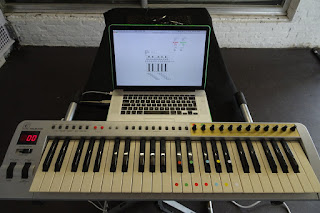marketed as a bass amp, this series of amps (the Supremes) was basically Vox cutting and pasting with different preamp modules and different power amps.
so this is a bass amp, because it lacks the tremolo and reverb as found on the guitar versions (the more notorious Defiants and Conquerors.)
>> here's a Defiant in front of a Vox Conqueror. ha. ha.
(did i tell you about how i met Yoko Ono at the vennice biennale in 2003? maybe some other time. she was nice, though.)
anyway, back to the amp - apart from these omissions, the preamps and the power amps are exactly the same. the distinction becomes pretty small, especially with there being a 'normal' and a 'bass' channel on the Foundation.. very Fender Bassman-ish, i guess.
and what do we see on the normal channel?
yes indeed - distortion, and the infamous MRB or mid-range boost. like a fixed wah. so, think that same White Pedal, but unwieldier. is that a word? yes, it is.
now this was for sale as is, meaning: it hums like a bastard and that's all she does. but since i could get my hands on it for less than the price of the above mentioned pedal, i decided i could always try to get the preamp (my section of interest) up and running and gut it for a True Vintage Kvlt Pedal or something.
i gave that a half-assed try at the time, noticed even the mixer section (mixing both channels together to feed the power amp) was giving me overdrive - not good - and put it aside as there were far more urgent matters to attend to.
and then, of course, it sat there on the shelf for two years plus.
last month, however, the global pandemic that is Covid19 allowed me the opportunity to lock myself in and get kicking on some projects that i had been neglecting for too long.
with some help from Nick over at www.voxsupreme.org.uk, i dated it based on capacitor codes etc.. this particular amp was placed rather firmly in february 1967. that makes it over 50 years old, and one of the earliest ones to survive at that. all of a sudden, the idea of tearing up an amp with that much history, and an amp type that's becoming increasingly rare at that, just for the preamp/fuzz.. i just couldn't do it. call me sentimental.
so i set out recapping this bad mofo.
out the window with vintage value, i say - the show must go on!
 |
| 'normal' aka guitar preamp board |
that same board after recap, for reference..
nice and shiny.
did every single board, replaced just about every cap in there, for both pre- and poweramps.
 |
| Full pre: 'normal', mixer, 'bass' boards. MRB caps + coils to the left. |
it still hums quite a bit, but in light of the signal to noise ratio, not a problem. because make no mistake: at 50 watts, this thing will blow the windows out of your neighbours apartment. it is not just loud. it is LOUD. like it's-the-sixties-and-what's-a-P.A.?-loud.
the sounds are more than decent for guitar, at least on the normal channel (the X-tone on the bass channel doesn't play nice with 6-strings). it does have that immediate directness i associate with high power transistor amps (jazz chorus, anyone?), which can be the greatest thing ever or the most annoying thing ever, depending on who you ask. honestly, i never could get along with those kind of amps - but i'm as yet undecided about this one, because unlike the jazz chorus it breaks up nicely and the fuzz is totally lovely. even if it is not as loud as the clean mode, and even if it pops like a basterd when switched on. the MRB might be more of a gimmicky feature than i had hoped, but i guess for studio use it can definitely have its moments. maybe i'll think higher of it after using it in a band situation. so i guess i'll have to play it some more to get used to it, because i'm really used to the sag and compression of my trusty AC15.. but it makes for an interesting addition to the family, to say the least.

























